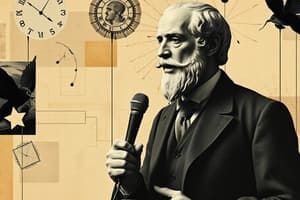Podcast
Questions and Answers
What is the primary purpose of Aristotle's Communication Model?
What is the primary purpose of Aristotle's Communication Model?
- To understand how to become a more effective and persuasive communicator (correct)
- To emphasize the role of feedback in communication
- To depict two-way communication between the sender and receiver
- To assign importance to the phenomenon of noise in communication
Which statement accurately describes Aristotle's Communication Model?
Which statement accurately describes Aristotle's Communication Model?
- It emphasizes the role of feedback and noise in communication.
- It is a linear model that depicts one-way communication and is used to communicate with the masses. (correct)
- It assigns equal importance to all elements of communication.
- It is a cyclic model that depicts two-way communication.
Which of the following is NOT one of the main elements of Aristotle's Communication Model?
Which of the following is NOT one of the main elements of Aristotle's Communication Model?
- Receiver (correct)
- Occasion
- Speech
- Speaker
According to Aristotle, which of the following elements has the power to improve communication?
According to Aristotle, which of the following elements has the power to improve communication?
In the field of accounting, what does 'Ethos' represent according to Aristotle's Communication Model?
In the field of accounting, what does 'Ethos' represent according to Aristotle's Communication Model?
Which of the following statements is TRUE about Aristotle's Communication Model?
Which of the following statements is TRUE about Aristotle's Communication Model?
Which of the following is an effective way for accountants to enhance their credibility?
Which of the following is an effective way for accountants to enhance their credibility?
What technique can accountants use to appeal to the emotions of stakeholders?
What technique can accountants use to appeal to the emotions of stakeholders?
Which aspect is essential for accountants when presenting financial data using logical appeal?
Which aspect is essential for accountants when presenting financial data using logical appeal?
What can Aristotle's communication model help accountants achieve?
What can Aristotle's communication model help accountants achieve?
Which aspect does the communication model emphasize regarding persuasive communication?
Which aspect does the communication model emphasize regarding persuasive communication?
What can the communication model provide insights into for daily personal life?
What can the communication model provide insights into for daily personal life?
Flashcards are hidden until you start studying
Study Notes
Aristotle's Communication Model
- Formulated by Aristotle before 300 BC, also known as the "rhetorical triangle" or the "speaker-audience-message" model.
- A linear model of communication, depicting one-way communication, used for communication with the masses.
- Created to understand how to become a more effective and persuasive communicator.
- Emphasizes the importance of understanding the audience and adapting messages accordingly.
5 Main Elements
- Speaker: the one who conveys the message
- Speech: the message
- Occasion: where/when/why the message is conveyed
- Target Audience: to whom the message is to be conveyed
- Effect: what impact did the message create?
Rhetorical Triangle
- Three elements that have the power to improve communication: ethos, pathos, and logos
- Ethos (Credibility): establishing credibility, crucial for maintaining trust with stakeholders
- Pathos (Emotional Appeal): using emotional appeal to communicate with stakeholders
- Logos (Logical Appeal): presenting financial data in a clear, coherent, and persuasive manner
Application in Accounting
- Establishing credibility by adhering to accounting standards and ethical guidelines
- Using storytelling techniques or real-life examples to illustrate the impact of financial decisions
- Presenting financial information in a structured format with clear explanations
Relevance in Daily Personal Life
- Provides insights into how to effectively influence and persuade an audience through the strategic use of ethos, pathos, and logos
- Emphasizes the importance of understanding the audience and crafting a persuasive message
Studying That Suits You
Use AI to generate personalized quizzes and flashcards to suit your learning preferences.




